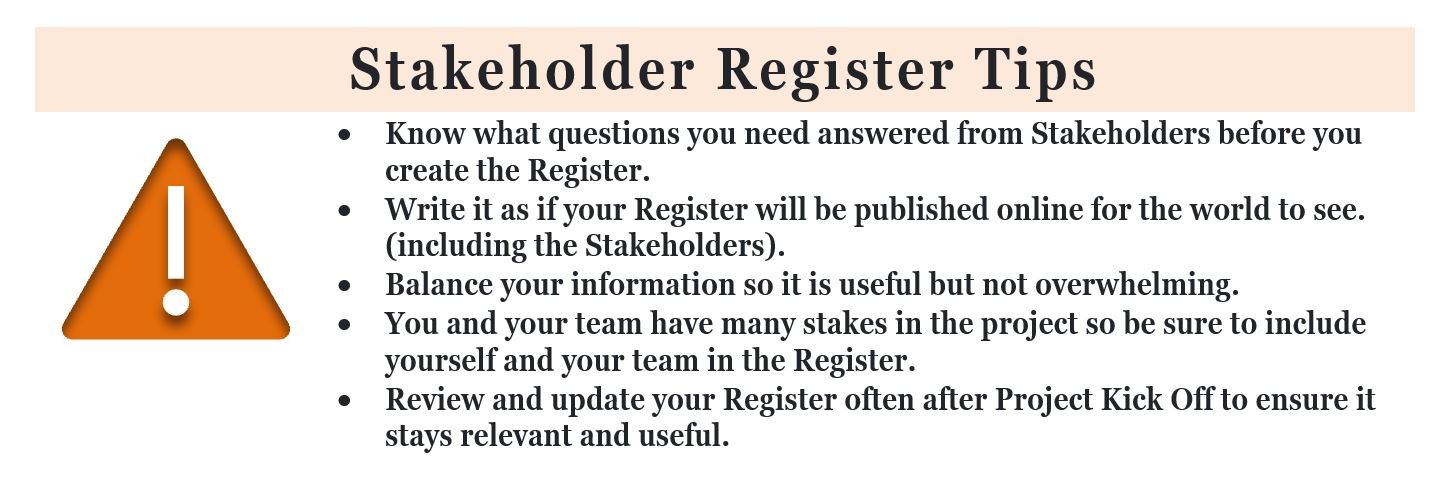Ever use that old saying, “a lot is at stake” when speaking to the impact an event can have on others? Stake refers to something to gain or lose; a stake in a new business means you want it to be profitable. A stake in a game can be a bet on the final score. Within any project, there are Stakeholders; entities to which there is an impact depending on the outcome of the project.
Whether you are a practicing Project Manager seeking to enhance your understanding of this important tool or a newer Project Manager prepping for your Project Management Professional (PMP®) certification exam, knowing who is a stakeholder and documenting key information in a register will benefit your work. Let’s dive in and see how to create a Stakeholder Register and explore it’s value.
On this page:
- Who Is A Stakeholder?
- Stakeholder Register Defined
- Stakeholder Register Categories
- Stakeholder Register Uses
- Stakeholder Register Benefits
- Stakeholder Registers for All

Get Your Comprehensive Guide to Risk Management
Learn how to manage risk in every project.
Who Is A Stakeholder?
The Project Management Institute (PMI®) defines a Stakeholder as:

What project managers must remember when identifying stakeholders is that it is not just a list of the names of those directly working on the project. It takes careful consideration of the scope and depth of a project’s potential outcomes (positive or negative) to accurately capture impacted organizations, groups, and individuals. Project Managers should conduct research to identify and understand potential stakeholders. Examples of three stakeholder categories are:

You will not have the same stakeholders for each project plan; however, it might be useful to use a common template for each project plan. You should go through the process of identifying all stakeholders anew for each project. Even if you have the same stakeholders in different projects the expectations and/or influence on the project will differ, thus impacting your project plan. Ask other project managers for examples of their identified stakeholders and, if possible, have others review who you have identified to better ensure you do not miss any.

Stakeholder Register Defined
“Stakeholder Register” is the term used by PMI® for the documentation tool that captures your stakeholder information. At the basic level, the Stakeholder Register is described as:

The Stakeholder Register is part of the overall project plan. It should be completed early in the planning process and updated as your plan evolves to reflect the project. There are several different tools and processes around Stakeholder Management, i.e., Stakeholder Analysis, Stakeholder Influence Matrix, and Stakeholder Register. It is the register which becomes a core planning tool and a resource used for the duration of the project.
Stakeholder Register Categories
Depending on whether you are an independent Project Manager, working at a small company, or part of a global organization, you may have to create your own register or use an existing template. In all cases, there will be core components arranged in a list so that you can sort and filter to key data. Consider these common data items for a Stakeholder Register:
- Type
- Name
- Job Title or Description
- Internal or External
- Project Role
- Preferred Communication
- Expectations
- Influence on Project
- Strategies
Depending on your work environment you should create useful categories in the Register to reflect specific needs of a given project. In the example shown, note that there is a Type listed; this is where you would note if the stakeholder were an organization, group, or individual.

Microsoft Excel is frequently used to create these Registers. An advantage of using Microsoft Excel is the ability to filter and sort your Register categories to highlight elements such as stakeholders of a certain type or influence.
There are guiding questions that project managers can use when creating their Stakeholder Register. The questions should be changed to best align with the specific project, company, industry, and situation. When reviewing a completed register, the project manager should be able to answer questions such as these examples:
- How many stakeholders does the project have?
- How can each stakeholder be contacted?
- Which stakeholders influence the entire project?
- Which stakeholders influence only certain segments of the project and which segments?
- What are communication preferences for each stakeholder?
- What are the communication frequency preferences for each stakeholder?
- Are there connections or interdependencies among stakeholders?
As the project manager works on the plan and the stakeholder register, there are several key tips to remember to better ensure a useful Stakeholder Register.

Do not put any information in the Register that would harm any of the stakeholders. The register should be saved with other project documentation and accessible to leadership, team members, and in some cases, other stakeholders.
Stakeholder Register Uses
The immediate value of the Stakeholder Register is as a guide for critical communications that enable the project plan to move forward. Stakeholders that are consistently provided relevant information are more likely to be project supporters and help enable project success.
The Register has others uses including as a tool for “…project/program planning, team forming and developing, defining success criteria, communications, governance, and defining tasks and responsibilities.” As you seek input from the project team and other stakeholders, you are demonstrating the value of other’s contributions from the earliest planning steps. It is an action that can garner not only the information for the register, but the confidence and trust of those working on the project and vested in its outcome.
In strict PMI® terms, and as reflected in the PMP® exam questions, the stakeholder register is an input into the project plan, schedule, and communication plan. It is also a tool for managing the diverse stakeholders for complex and extended projects.
Studying for the PMP Exam?
Stakeholder Register Benefits
There are benefits to the creation of a Stakeholder Register, including the knowledge gained through the necessary research. The International Organization for Standardization (ISO) provides a powerful list of insights that can be gained via stakeholder research and register work. Example insights to be gained include:

The example questions from ISO provide insight into how the stakeholder register template can be structured to glean critical insights into the connections and interdependencies among different entities.
Stakeholder Registers for All
Traditionally, Stakeholder Registers fall within planning work of traditional (waterfall) project management. It is completed in the “Identify Stakeholders” process and updated within the “Communication” and “Direct and Manage Project Work” processes. A close review of the PMI® Guide to the Project Management Body of Knowledge (PMBOK® Guide) will grow your understanding of the “what and when” for stakeholder registers from a process standpoint.
If you are working in project or portfolio work, in traditional or Agile, knowing the purpose and the uses of the Stakeholder Register will help your work as a PM and in taking the PMP® certification exam. Remember, the questions can be process-oriented or scenarios in which you must deduce the best choice from multiple options. The project manager that systematically and thoroughly sets up and maintains the Stakeholder Register can prevent communication problems, which in term supports efficient work overall.
Upcoming PMP Certification Training – Live & Online Classes
| Name | Date | Place |


 New Horizons
New Horizons
 Project Management Academy
Project Management Academy
 Six Sigma Online
Six Sigma Online
 TCM Security
TCM Security
 TRACOM
TRACOM
 Velopi
Velopi
 Watermark Learning
Watermark Learning
 Login
Login




 New Horizons
New Horizons
 Project Management Academy
Project Management Academy
 Velopi
Velopi
 Six Sigma Online
Six Sigma Online
 TCM Security
TCM Security
 TRACOM
TRACOM
 Watermark Learning
Watermark Learning